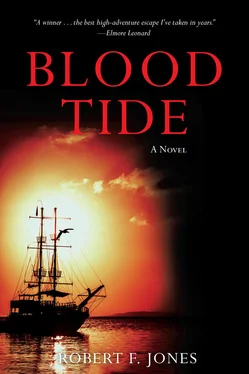Robert Jones - Blood Tide
Здесь есть возможность читать онлайн «Robert Jones - Blood Tide» весь текст электронной книги совершенно бесплатно (целиком полную версию без сокращений). В некоторых случаях можно слушать аудио, скачать через торрент в формате fb2 и присутствует краткое содержание. Год выпуска: 2014, Жанр: Старинная литература, на английском языке. Описание произведения, (предисловие) а так же отзывы посетителей доступны на портале библиотеки ЛибКат.
- Название:Blood Tide
- Автор:
- Жанр:
- Год:2014
- ISBN:нет данных
- Рейтинг книги:5 / 5. Голосов: 1
-
Избранное:Добавить в избранное
- Отзывы:
-
Ваша оценка:
- 100
- 1
- 2
- 3
- 4
- 5
Blood Tide: краткое содержание, описание и аннотация
Предлагаем к чтению аннотацию, описание, краткое содержание или предисловие (зависит от того, что написал сам автор книги «Blood Tide»). Если вы не нашли необходимую информацию о книге — напишите в комментариях, мы постараемся отыскать её.
Blood Tide — читать онлайн бесплатно полную книгу (весь текст) целиком
Ниже представлен текст книги, разбитый по страницам. Система сохранения места последней прочитанной страницы, позволяет с удобством читать онлайн бесплатно книгу «Blood Tide», без необходимости каждый раз заново искать на чём Вы остановились. Поставьте закладку, и сможете в любой момент перейти на страницу, на которой закончили чтение.
Интервал:
Закладка:


For Leslie,
who sails deeper seas
On men reprieved by its disdainful mercy, the immortal sea confers in its justice the full privilege of desired unrest.
—JOSEPH CONRAD
Excerpt from The Philippine Pilot , vol. IX
15. FLYAWAY ISLANDS
This chapter describes the Islas Efemerales, or Flyaway Islands, marked on some charts as Dampier’s Folly. From NE to SW the group includes San Lázaro, Balbal, Moro Armado, and Perniciosa, along with some three dozen islets and atolls that are seasonally inhabited, if at all. Lying in the Sulu Sea midway between Palawan and Mindanao, some seven hundred sea miles southwest of Manila, the group is rarely visited. (See “Caution.”)
San Lázaro, the largest island, is about twenty-seven miles long, NE to SW, and seventeen miles wide. The interior is mountainous, heavily wooded, and cut with deep ravines known locally as laberintos venenosos for the poisonous snakes, insects, plants, and Negrito headhunters inhabiting them. The highest mountain is an active volcano, Mount Haplit, with an elevation of 2,819 feet. Its smoke plume is often visible at a distance of fifty miles. Close to the coast are many seemingly fertile valleys interspersed with old lava flows and narrow strips of apparently cultivated lowland, from which the mountains rise abruptly. Beaches of red and black sand comprise the leeward shore of the island, supporting lofty, wind-tossed stands of coco palms. Attractive as they appear from the sea, the beaches are infested with hordes of disease-bearing sand fleas ( pulgarenas in the local dialect) and should be avoided by visitors.
Balbal is similarly mountainous, with 1,699-foot Cerro Corsario rising in pyramid shape from its center, and thickly forested. Formerly a base for Dyak and Tausuq sea raiders, the island is now reportedly occupied only by a small band of animist indigenes related to the “gentle Tasaday” of Mindanao. Rare mouse deer, peacock pheasants, giant carnivorous flying squirrels (the balbal for which the island is named), and the small, fierce, V-horned wild buffalo known locally as tamarau are also present in delicate balance with the aborigines. To preserve that balance, Philippine President Ferdinand Marcos in 1978 placed Balbal off limits to visiting vessels. The ban, though rarely enforced, remains in effect.
Moro Armado is a hilly, scrub-grown, boomerang-shaped island twelve miles long by four miles wide. Surrounded by abrupt fringing reefs, its most prominent feature is a complex of salinas , or salt pans, at the S end into which the tide flows. These salinas are diked and controlled by sluice gates to permit the entry, entrapment, and evaporation of seawater, and are mined in rotation for the resulting salt. The labor was performed in the past by indentured mineros , who lived in coral-block huts the size of dog kennels. Currently the task falls to political prisoners and hostages whose plaintive cries and work chants can be heard far offshore, especially on a NE wind.
Perniciosa, flat, corralled, and uncharted, is visited only by snake hunters and malaria researchers. A Japanese submarine refueling depot was located here during World War II but abandoned in 1944 due to disease and guerrilla raids.
The sea bottom surrounding the Flyaways is rugged and rapidly variable. A “Dangerous Ground” of reefs, shoals, trenches, shifting sandbars, and submarine ledges (called putas in local parlance) girds and interpenetrates the main group, rendering approach hazardous even to the best-equipped vessels.
Wrecks abound.
History . Obscure, violent, mythic, and not yet written.
COLREGS Demarcation Lines. International rules of the road apply.
Vessel Traffic Management . Not applicable.
Anchorages . Variable, dependent upon wind, tide, current, and political developments. A good weather eye and a busy leadsman in the chains afford the best assurance against grounding. All anchors should be buoyed for quick slippage and an anchor watch maintained at all times. (See “Caution.”)
Tides . Probably semidiurnal on the South China Sea side of the group, diurnal in the Sulu Sea. Tide tables for these waters have not yet been compiled.
Currents . Little known, though a NW current of twelve to twenty knots may set directly through the islands and their outliers, at least during certain months.
Weather . Mild to severe, year around. The outstanding feature of the marine weather is its unpredictability. Trade winds and monsoons are frequently interrupted by cold fronts that reach the islands from as far away as Tibet and Mongolia. Gale-force winds, though unlikely, can drop with great suddenness from seemingly clear skies. These squalls are known locally as vientos azores , or “hawk winds,” for the swiftness and ferocity of their descent. Seas in the area usually run about ten feet, but have reached forty feet or more on occasion. Waterspouts are common.
Storm-Warning Displays . These are unknown in the Flyaways.
Pilotage . Unreliable. (See “Caution.”)
Towage . Hazardous. (See “Caution.”)
Quarantine . Not required. (See “Caution.”)
Customs . Ruinous. (See “Caution.”)
Immigration . No passport or visa is required of anyone seeking to enter the Flyaways.
Supplies . Bunker fuel, diesel, and gasoline are rarely available. Most fuel sold to visiting mariners has been purposely diluted with water or spiked with corrosives. Sugar is frequently added to gasoline so as to burn pistons and render visiting vessels inoperable. Fresh meat, fruit, and vegetables can be purchased, along with casks of supposedly fresh water, from local pump boats. A frequent, low-cost offering is the native rum, a potent drink called tuba asesina (see “Caution”). All such produce should be thoroughly examined, washed, strained, peeled, cooked, or otherwise tested (perhaps on the ship’s cat) before human consumption. Ice, yeast, and stationery are sometimes available in the bicycle shop above the Carniceria Cabrónes near Love Boat Wharf at Avenida Putissima.
Repairs . The Vela Vieja Sail Loft at Narr Lagoon on Moro Armado is equipped with a deep-throat (thirty-seven-inch) sewing machine. One-Eyed Balabatchi, a shipwright on San Lázaro, does excellent if expensive work in both wood and fiberglass (ask for him at the Millikan Shipping offices opposite the mosque on Dewey Square in Lázaro City). Though all Flyaway Islanders are competent mechanics, requests from visiting mariners for engine repairs are often construed as invitations for sabotage (see “Caution”).
Communications . Roads between principal ports and towns are poor, unpaved, rutted, and beset by bandits. Bridges over the many streams that drain the higher islands are few, flimsy, poorly maintained, and exorbitant in their toll rates. The islands have no air service. Though steamship lines from Manila, Puerto Princesa, and Zamboanga served the islands in years past, the looting and subsequent sinking of a Hong Kong cruise ship at dockside in Lázaro City in 1978 caused termination of passenger service. Only small, interisland vessels called kumpits now operate in the Flyaways (see “Caution”). Telephone, telegraph, and radio communications to the outside world have never been available, and probably never will be.
Читать дальшеИнтервал:
Закладка:
Похожие книги на «Blood Tide»
Представляем Вашему вниманию похожие книги на «Blood Tide» списком для выбора. Мы отобрали схожую по названию и смыслу литературу в надежде предоставить читателям больше вариантов отыскать новые, интересные, ещё непрочитанные произведения.
Обсуждение, отзывы о книге «Blood Tide» и просто собственные мнения читателей. Оставьте ваши комментарии, напишите, что Вы думаете о произведении, его смысле или главных героях. Укажите что конкретно понравилось, а что нет, и почему Вы так считаете.












